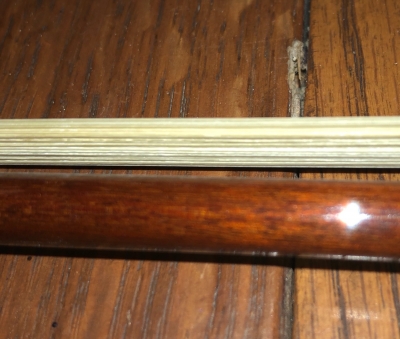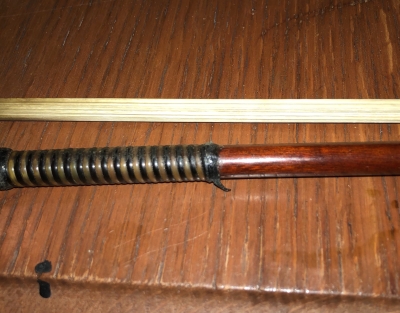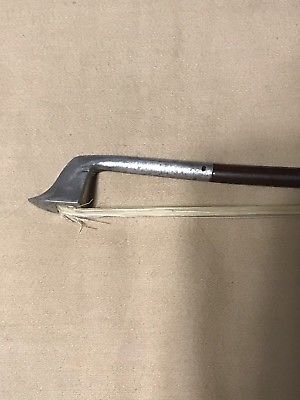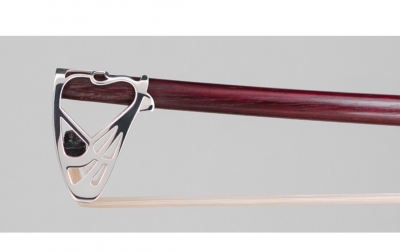Welcome to our forum. A Message To Our New and Prospective Members . Check out our Forum Rules. Lets keep this forum an enjoyable place to visit.
Currently working on errors from the latest (SimplePress) forum update. Many issues have been resoled and others are being worked on. Thank you for your patience.
 Topic RSS
Topic RSS



 (6 votes)
(6 votes) Regulars
 Offline
Offline
Mackenzie has a Glasser carbon fiber that she likes really well that came with her Gliga, but I’m pretty sure she likes her wooden bow better, I think it’s a pernambuco bow that is from the early 20th century that we rehaired.
We have a hoard of old bows that I can work on, balancing, straightening, regripping and rehairring.
I have lots of bows including viola, cello and bass along with violin and there are quite a few nicer named bows.
you can tell the obvious bad bows and also the ones that have a good chance of being good.
the student quality and fractionals we will be donating to the school program as we get them done , plus we are going to do some rehairing for the school.
Irv, I was wondering what you were going to use for your tips on your bamboo sticks?
Regulars
 Offline
Offline

@steveduf and others. Most of the work involving the bamboo bow I am adapting from the Cocker British Patent. He made use of two scarf joints. He glued a conventional head onto a six sided bamboo stick. In the second joint under the thumb pad, he jointed the six sided bamboo to a pernambuco eight sided stick fragment so that he could use a conventional frog. Almost all bamboo fly rods also use six segments due to favorable construction geometry (the strips are easier to plane that way without damaging the “power fibers” located adjacent to the skin of the bamboo). I am attempting to use eight strips to save a scarf joint. Now, to your question.
The grain pattern in the wood favorable to stick strength makes for a weakness in the bow head. For the first runs, I plan to bond a carbon fiber bow head onto the bamboo stick using golf head epoxy. If the bow is successful, I plan to use a hydro press molded metal head similar to the second photo (but lacking the self rehair feature).
Success is the progressive realisation of a worthy ideal. —Earl Nightingale.
Regulars
 Offline
Offline

I should have three high quality Brazil wood bows of the same German maker by next week. All in need of a rehair. I know that “roasting” changes the frequency response of maple. I made a bamboo segment roaster long enough to accept a violin bow. I think that it would be interesting to roast one of the bows at random and see what happens.
Success is the progressive realisation of a worthy ideal. —Earl Nightingale.
Regulars
 Offline
Offline
Irv,
the reason I ask is this...
i have a number of old bows, (way too many)
some of these are broken and was wondering if you could use some of the parts... free of course
almost embarrassed to show this picture...
this about 80% of my bows. There are a lot of really nice bows that I can’t wait to get operational

Regulars
 Offline
Offline

Hi @steveduf. Sold. I will gladly pay postage, of course. Do you have any that you want that I can rehair for you (it will have to be black hair, since it is the only type I have). I also have tungsten wrap wire of two flavors (black and gold plated) and two kinds of thumb pad (kind of platinum colored kangaroo leather and patterned black sheep skin).
The major reason for my interest is that I only have a few stick taper patterns and I want to create an index of them for violin, viola, cello and bass. That seems to be a trade secret, or they don’t much bother any more. I also may need head ends if I cannot bond cf to bamboo.
Success is the progressive realisation of a worthy ideal. —Earl Nightingale.
Regulars
 Offline
Offline
Irv
i would be happy to help with stick profiles and patterns for your index.
i had already decided to basically do a little of the same. For instance I have four or five generic Bausch bows... I wanted to measure OA length, balance point and weight of the bare stick, weight of existing frog if present. Measurements of critical points on the stick. One reason I want to do this is two-fold. One is to be able to compare while working on bows in general. But also I have a few bows that I think might be decent wood but are bulky and just not worked down to quality shape and it would be fun to see if they would decent after re-working.
Regulars
 Offline
Offline

Steve.
I will direct you to two references I have found on the internet.
The Violin Bow: Taper, Camber and Flexibility by Colin Gough (2011 Acoustical Society of America). pages 4105-4116.
On Page 4109, Vuillaume’s algebraic expression of Toute bows is given. It is far from a linear taper.
A Bow on the Couch by Andreas Grutter. In chapter 8, he discusses a Dominique Peccatte Bow. His index uses both vertical and horizontal measurements, since he found that many good bows are ovals. An example
Bowhead. 10. 20. 30. 40. 50. 60. 70. cm distance from head
5. 6. 8. 7.5. 7.8. 8.2. 8.4. 8.4 mm vertical height
4.8. 5.9. 6.8. 7.3. 7.6. 7.8. 8.2. 8.4 mm horizontal width
Still interested?
Success is the progressive realisation of a worthy ideal. —Earl Nightingale.
Regulars
 Offline
Offline


Those are some interesting numbers, Irv... especially around the 50cm from the head mark. That's a 4mm difference between vertical height (8.2) and horizontal width (7.8). Since I figured that would be visible to the eye, I went to check my couple of bows and they all look pretty cylindrical around the 'waist'.
If I had to guess, I'd say that, that slight oval shape is a way to achieve more stick strength while keeping the weight down... but I'm also guessing that there's more to it than that.
Regulars
 Offline
Offline

Regulars
 Offline
Offline


Regulars
 Offline
Offline
Irv
yes I’m in
just bear with me
Fiddlerman ,
it IS an obsession
i have obtained them from all over the place.
auctions, Craigslist, bought 50 or so mostly 4/4 from an estate of a luthier, a lot of nice sticks but needing quite a few frogs.
Just getting into balancing, grips and such.
a lot of fun to pick out a nice violin or bow in distress and making something out of it.
Mack is lucky also getting to try out a lot of different stuff .
Regulars
 Offline
Offline

Regulars
 Offline
Offline
Honorary advisor
Regulars
 Offline
OfflineRegulars
 Offline
Offline

I am confused. I just finished a Youtube video featuring Allison, the on line violin instructor from Great Britain, regarding what to look for in a violin bow. Weight and balance point. Nothing regarding response at all.
Success is the progressive realisation of a worthy ideal. —Earl Nightingale.
Regulars







It may be because of her intended audience, which is essentially all beginners given the topics of her tutorials. The conventional wisdom, which may or may not be correct (and probably also depends on the individual student), has been that beginners have an easier time controlling stiffer bows and should use one until they start learning bow strokes that require a bouncing bow.
Here's what Strings Magazine has to say about it. The two main characteristics this article recommends looking for are balance point and response.
Regulars
 Offline
Offline

Regulars
 Offline
Offline
Fiddlerman said
@steveduf - If you ever visit, bring some stuff with you. Do you keep track of the names on the old Pernambuco bows or are they all cheap bows?
I thought we were going to make a few months ago. Mack had a softball camp at FIT, I assumed because it was on the east coast that it wouldn’t be far... lol, still 2 1/2 hours north.
I still have an issue with completely being sure on pernambuco. I think I do...
this bow pictured doesn’t show the detail I’d like. It has a certain iridescent look to it with grain running both directions, kinda like a mesh. It has whalebone wrap with a silver trimmed frog, it weighs in at 57 grams. It is only stamped Germany.
Some of the other bows that I believe are pernambuco are a HOMA, a Leon Pique, an Albert Richter cello, a pfretchner and a few others. 





 Log In
Log In Register
Register
























